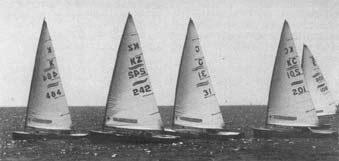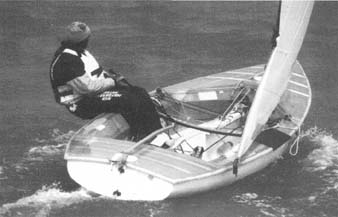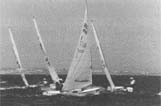| 20. From the
Experts |
by
Pat Healy |
|
In 1980, the U.S. was in the enviable position of having more high calibre
Finn sailors than any other country, with Americans totally dominating the
previous three Gold Cup events. So powerful was the U.S. contingent that,
prior to the announced boycott of the 1980 Moscow Games, speculation in
foreign sailing circles revolved not around which country would win a Gold
Medal in Finns, but rather, which American would win a Gold Medal in Finns.
With such tremendous talent at hand, YR/C Contributing Editor/Finn sailor
Pat Healy, who also coached the Naval Academy Sailing Team and, when travelling
abroad, the U.S. Firm representatives, assembled the ideas and comments
of five highly regarded American Finn sailors to create this "From
the Experts".
Included were:
John Bertrand 6'1", 185 lbs. Finn Gold Cup 1st (1978), 2nd (1979),
2nd (1980); Finn Europeans 1st (1979), 2nd (1980); US Trials 1st (1980)
Andrew Menkart, 6'1",185 lbs. Finn Gold Cup 4th (1979), 5th (1980);
US Trials 2nd (1980)
Cam Lewis, 6'1", 190 lbs. Finn Gold Cup 1st (1979), 1st (1980); US
Nationals 1st (1979)
Carl Buchan, 6'5", 195 lbs. Finn Gold Cup 3rd (1978), 6th (1979) Stewart
Neff, 6'1", 210 lbs. Finn Gold Cup 5th (1979); Nordics 1st (1979);
US Trials 5th (1980)
|
Over the years, Finn sailors have been stereotyped as fair-haired
endomorphs that could take on an entire football team in a street
brawl and win. In a way, this may be possible, since the majority
of top Finn sailors are over six feet tall and approach 200 pounds.
But there's more to the Finn class than simply raw beef. A close inspection
of the resumes of present and past championships in a number of other
classes reveals a common thread - the Finn. George O'Day, Bruce Goldsmith,
Charles Ulmer, Robbie Doyle, Peter Barrett, Gordy Bowers, Dick Tillman,
Bill Cox, Tom Allen, Glen Foster, Andy Kostanecki, Harry Anderson
- all have been indoctrinated to the finesse and toughness of sailboat
racing via the Finn.
|
 |
|
What makes the Finn so demanding is not only the intense calibre of competitor
it attracts, but also its sheer size. Designed in 1949, the Finn's weight,
at 319 pounds, is high by modern standards. Coupled with 115 square feet
of sail, it takes size and strength to hold the boat down in a breeze. Therefore,
those who succeed in the Finn class must not only be able to meet the physical
standards set by the boat, but at the same time, they must be able to think
clearly and quickly and to meet the strategic and tactical standards set
by their competitors.
|
 |
Hulls
The major North American Finn manufacturer, Vanguard, has all but
cornered the world market in Finns, with half of their 1980 production
scheduled to be shipped outside the U.S. Used by all five of these
Finn sailors, the current Vanguard hull has been optimised to the
point where what has evolved is a shape that is fairly narrow and
as straight as possible on the waterline, but as wide as possible
in the transom area, all within the limits of the class rules. "The
bigger transom makes Vanguards a little quicker to plane," says
Buchan, "and the narrowness makes them a little faster upwind,
particularly in light air. It does make them a little tippier, though." |
With wide acceptance of the Vanguard hull shape, the most recent concerns
have focused on weight in the ends and the centre of gravity, both of which
have to do with pitching moment. To determine the location of the centre
of gravity and the amount of weight in the ends, making sure both are within
class rules, moment-of-inertia tests are made on each hull at some major
Finn events. Most Finns come out of the mould on the light side and are
brought up to weight by adding lead corrector weights, the placement of
which can affect the moment-of-inertia tests. "If you've got to add
much lead," says Lewis, "be sure you don't put in separate pieces
of lead in different parts of the boat. For example, don't put some lead
up by the mast step and some back by the centreboard. Keep the lead together
and generally try to keep it as far aft as possible. In that way, the weight
is over the wider, flatter stern section, which is the most buoyant part
of the boat."
Most modifications made by Bertrand, Buchan, Lewis, Menkart and Neff fall
into two categories - the relatively easy, straight forward work and the
major structural projects. Some of the more easily made modifications include:
1. To help stiffen the thwart and reduce sideways centreboard movement,
all five have glassed in wood support pieces under the centreboard cap and
traveller.
2. The forward hiking strap base location has been adjusted to accommodate
individual leg length. The longer one's legs, the further inboard the base
is mounted. Some, such as Menkart, have mounted the bases on short lengths
of track, allowing them to be slid inboard or outboard as conditions change.
3. Each of the five uses a compass, but there are different ideas about
how many to use, where to mount them and when to use them. Bertrand has
been known not to use a compass at all, relying instead on angles of surrounding
boats to give him an idea of whether he's being headed or lifted. However,
for the 1980 U.S. Trials, he did add a center-mounted compass, carried on
a small base off to one
side of the centreboard trunk, by the thwart. Buchan also carries his compass
there, but admits to only occasionally using it. "Probably the only
time I use my compass," says Buchan, "is when rounding the leeward
mark. It gives me a quick reference as to what the wind is doing."
Menkart and Neff also carry center-mounted compasses. "I like the single
compass because it's difficult to get side compasses to read the same,"
says Menkart, "and it helps keep weight down a little." Lewis
is the only one who carries dual side compasses. "I don't want to have
to look in the middle of the boat to read the compass," says Lewis.
"My compasses are mounted so that, when I'm in a hiked position, they
are right in line with my eyes and the front of the boat. In that way, I
never have to look very far away from where the boat's heading."
4. Each has customised the side tank pads to one degree or another. In general,
the longer your legs, the more padding you need to increase the distance
between your calf and thigh and help keep your derriere out of the water
when hiking. Since all five are relatively tall, each uses two or more thicknesses
of padding on each side of the boat. Menkart has taken pad modification
a step further by shortening them, fore and aft. "I made them just
wide enough to hike on," says Menkart, "so that the boom will
not hit the pads when sheeted in tight. That allows the boom to be carried
a little closer to the deck." (Because the mast is so far forward,
the boom is never carried further inboard than the leeward side tank.)
|
The major construction
questions revolve around double bottoms and whether or not to utilise
Menkart's 'Laser' deck layout. At the 1979 U.S. Pre-Trials, only Bertrand
and Buchan carried a double bottom, which is basically plywood glassed
over the aft half of the cockpit to create a watertight compartment. "The problem," says Buchan, "is that Vanguard hulls
have a lot of stringers in them, along which water tends to collect.
The double bottoms cover those, allowing the boat to stay a lot drier."
At this year's Olympic Trials, practically everyone had a double bottom
of one form or another. Bertrand, Buchan and Neff carried the idea
one step further by extending the double bottom up toward the forward
bulkhead, along each side tank, which provides a small 'canal' along
the centreboard trunk where water can be funnelled aft to the bailers,
"The dryness is really important when going into that first reach,"
says Buchan. "If your boat is dry as you start that reach and
others have water sloshing around, you're going to be a lot faster."
|
 |
|
For deck layouts, one of the problems with having all major control lines
passing through the deck around the mast area, as traditionally done, is
that water passes through there as well, adding weight to a weight-sensitive
section of the boat. Menkart overcame much of this problem by deck-mounting
all of his control lines. By so doing, he sealed off the front of the boat.
To prevent water from entering where the spar passes through the deck, he
globs grease on the mast collar, which, even on a heavy-air day, prevents
all but a couple of spongefulls of water from entering. According to Menkart, "There is a bit more windage with the control lines in the open, but
there's already a lot of turbulence around the gooseneck and splash rail
anyway. And a little turbulence is better than having water rush up to the
bow and sink the boat."
The other four sailors stuck with the standard layout or some variation
thereof. Neff has worked out a fairly simple valve system.- "I have
a bulkhead up there," says Neff, "that has a small, neoprene flap,
on each side of the centreboard trunk. Water can ran aft through the flaps,
but not forward." Lewis simply built the bilge area up around the mast
step with micro balloons, thus creating a small 'ramp' which helps funnel
any water aft.
|
 |
One other major modification deals with the centreboard. Standard
Vanguard Finns come with five-sixteenth-inch wide boards. However,
the Vanguard centreboard trunk will accommodate up to a three-eighth-inch
board. Consequently, Lewis, along with several others, has switched
to the thicker board. "According to engineers, the wider board
is considerably stiffer," says Lewis. "It is, however, eight
pounds heavier than the standard boards, but because the weight is
centralised and down low, I don't think that the added poundage outweighs
the advantages gained by the extra stiffness." Menkart solved
the extra weight problem by cutting out a section in the top of the
board.
|
|
|